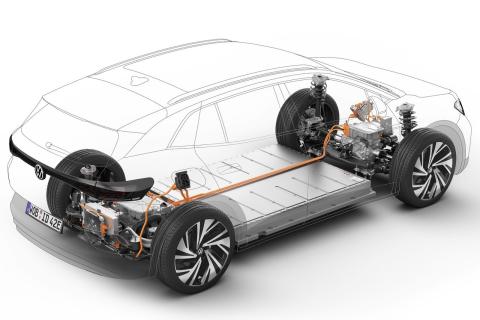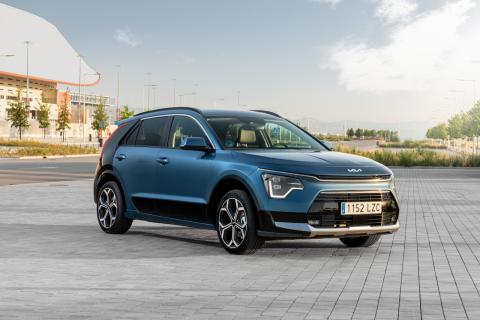
Making the leap to electric mobility is on the minds of many drivers. The options on the market are increasingly numerous, not only in terms of brands and models; also by level of electrification. Choosing the most convenient electrified car does not have a single answer; It depends on what you are going to use it for.
Next, we collect all the electrical technologies of the moment. The idea is that you discover the keys to each of them and the needs that, a priori, they are intended to cover.
We go from greater to lesser degree of electrification.
EV (Electric Vehicle)
The EV (Electric Vehicle) or VE (by the meaning of its acronym in Spanish, Electric Vehicle) are models powered solely and exclusively by electric motors. The following two types of electric vehicles arise from how they obtain energy: BEV, when they are plugged into a power outlet, or FCEV, when they are powered by a fuel cell.
BEV (Battery Electric Vehicle)
BEV stands for Battery Electric Vehicle, that is, battery electric vehicle.
They work thanks to one or several electric motors that obtain the energy they need from one or several batteries. These are recharged connected to a plug that can be domestic or wallbox (the former require more waiting time).
Their autonomy, that is, the kilometers they can travel with each recharge depends on the capacity of the battery, as well as factors such as weight, aerodynamic resistance…
Some examples of BEVs are the Tesla Model 3 or the VW ID.3.
FCEV, hydrogen cars
FCEVs are hydrogen cars. They are also one hundred percent electric vehicles, with the peculiarity that the generation of electricity is carried out through a chemical reaction known as electrolysis. They don’t need a plug to recharge, but instead refuel at stations known as hydrogen generators.
As main advantages compared to BEVs, which offer more autonomy and less recharging time; On the contrary, they are more expensive and the network of recharging points is still very small.
In this link you have all the hydrogen models that are sold today in Spain.
Electric cars, no more than 300 km and, better, in the city
Although this statement will have to be changed in a short time, today, electric cars continue to be an eminently urban option.
Manufacturers have made an effort to extend the kilometers that can be traveled with each recharge and the average is around 300 km. But there are two drawbacks that make it difficult to use on longer routes: the first is the recharging infrastructure, which, although it is true that it is in full expansion, still leaves many geographical holes in which the presence of chargers is insufficient.
The second is the longer recharge time than combustion models (not in the case of hydrogen models).
PHEV (Plug-in Hybrid Electric Vehicle)
PHEVs are plug-in hybrid vehicles, that is, those that combine a combustion engine (normally powered by gasoline) and an electric engine (there may be one or more) that, depending on the moment or the driver’s order, work independently or joint.
In this case, the battery is larger (in capacity) than HEVs, but smaller than BEVs, and is recharged by plugging into a wall outlet.
More and more manufacturers are opting to electrify their range of vehicles with a plug-in hybrid variant. The best-selling PHEVs of the moment are the Lynk&Co 01, the Kia Niro PHEV and the Hyundai Tucson Plug-in Hybrid.
For families who do many kilometers
Plug-in hybrids are the best option for drivers who do many kilometers and want to reduce fuel consumption and, incidentally, lend a hand to the environment.
In electric mode, they travel an average of 50 km, enough to wear the DGT Zero Emissions label with the advantages that this brings: unrestricted circulation in Low Emissions Zones, free parking, maximum Moves Plan bonus…
HEV (Hybrid Electric Vehicle)
The translation of HEV is non-plug-in hybrid vehicles, that is, conventional hybrids that combine a combustion engine and an electric one, but the energy of the latter is not obtained from a plug but from the operation of the thermal engine itself, especially in braking and accelerations.
HEVs use a battery to store that energy, but their capacity is very low, so they travel very few km in electric mode. The most popular example is the Toyota Prius.
Best for trips out of town
Non-plug-in hybrids reduce consumption compared to their combustion alter ego thanks to the support of the thermal engine at certain times, but the savings are much less than with a PHEV.
They are listed as ECO vehicles by the DGT. This means that although they have more economic and circulation advantages than thermal ones, they are below Zero Emissions. If you plan to use the car for an eminently urban use, it is better that you go to the next section, that of the PHEV, since you will not have restrictions when driving through the Low Emission Zones (ZBE).
Mild Hybrid (or microhybridization)
Also known as mild hybrids, Mild Hybrid vehicles use 48-volt hybrid technology. This works in combination with a combustion engine (either diesel or gasoline) that is supported by another electric one (48 volts) that adds about 12 kW of additional power.
This extra power is used in various phases of driving, such as starting, acceleration and braking, thus reducing fuel consumption by around 7%.
Some examples on the market: Seat León eTSI, Hyundai Tucson 48v, Suzuki Cross Mild Hybrid or Skoda Octavia e-TEC.
For those who hesitate to switch to the electric car
Mild hybrids are the option chosen by those who seek to reduce fuel consumption but are not sure about having to look for a plug.
The 48-volt technology means that they meet the conditions to wear the DGT ECO label, so they have more discounts on the purchase (for example, they do not pay registration tax) and they can access the ZBE with fewer restrictions.



